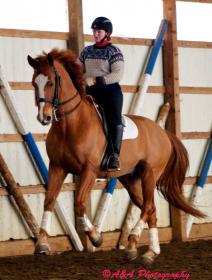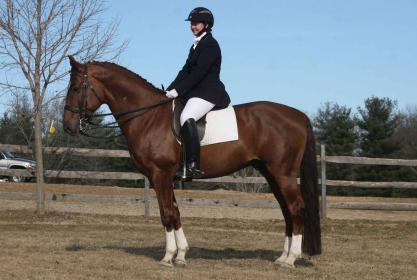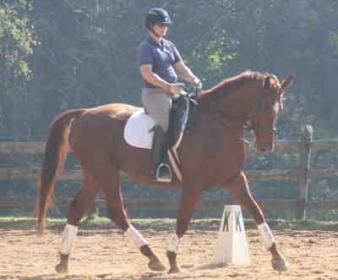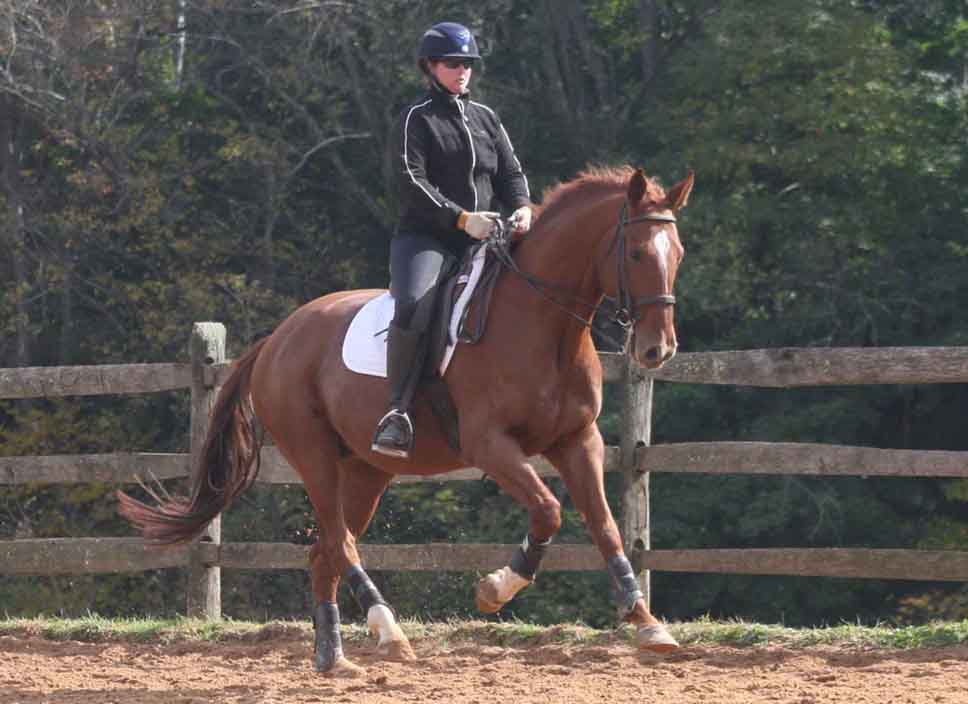[QUOTE=DancingFoalFarms;6888212]
Well, the genetic difference aside (and that’s a pretty important difference), duns and buckskins have different characteristics. A dun has leg bars (stripes), zippers, cobwebbing, and a strong dorsal stripe. A buckskin without the dun modifier doesn’t have any of those things  Calling a buckskin a dun would be like calling all roan horses grey – they may share similarities, but they’re not the same thing. Dun Central Station has some great info. BTW – I only learned this because by a twist of fate, I ended up with two duns – a grulla and a dunskin. :)[/QUOTE]
Calling a buckskin a dun would be like calling all roan horses grey – they may share similarities, but they’re not the same thing. Dun Central Station has some great info. BTW – I only learned this because by a twist of fate, I ended up with two duns – a grulla and a dunskin. :)[/QUOTE]
Actually, the only requirement is they have a dorsal stripe  They don’t have to have the leg or wither barring, or face mask/cobwebbing. Even the dorsal stripe doesn’t have to be so strong, and if it’s a pale color, it might not be easy to see
They don’t have to have the leg or wither barring, or face mask/cobwebbing. Even the dorsal stripe doesn’t have to be so strong, and if it’s a pale color, it might not be easy to see 
“should have” - really sorry, but that’s such a huge peeve of mine 
taken into consideration the fact that the majority of the world uses the term “dun” for a buckskin - and perhaps they could of used a different name for the genetic “dun” ?
I don’t think the majority uses that term, actually. And bay dun, which has been named so for a long time, is the original color - everything else, meaning black, chestnut, lack of dun, etc, is a mutation.
do you get what i mean?
LOL, nope 
[QUOTE=Renascence;6888437]
Yes I said Chestnut is a dominant color. Doesn’t recessive mean a hard to get trait?..My theory that chestnut is a common color because it is a dominant color. I have the theory that some riders may want a rarer color since that may seem more special to them. I offered that up because the OP wondered about chestnut hate.:)[/QUOTE]
E is the black form of the Extension locus, e is the not-black form, aka red. ee makes for a red-based horse - not necessarily chestnut, depends on the rest of the genetics.
E is dominant over e - e is recessive.
ee is not dominant - it is a recessive form of Extension that only makes its presence visible when in the homozygous state.
It’s only a “common color” when it becomes bred for, because then breeding chestnut to chestnut guarantees chestnut. It’s not rare at all in the equine world in general, though certain breeds have bred it out - no red Cleveland Bays, for example  - and some have nearly bred it out and won’t register any reds - Friesians. But look at the QH world - fill to the brim with chestnuts.
- and some have nearly bred it out and won’t register any reds - Friesians. But look at the QH world - fill to the brim with chestnuts.
[QUOTE=catzndogz22;6888688]
I was surprised to learn that chestnut is recessive as well… so I googled it. It’s my understanding that although chestnut is recessive, the majority of horses carry the chestnut gene, which is why they’re common.
This explains it very well: http://www.ultimatehorsesite.com/colors/chestnut.html[/QUOTE]
Looking at the population as a whole yes, most of them are heterozygous black - Ee - carrying 1 copy of not-black/red/chestnut. But that alone doesn’t make chestnut common - breeding 2 Ee horses only gives you a 25% chance of producing a chestnut, so if you only bred Ee?? horses, only 25% of the population would be chestnut.
But, if you start breeding for chestnut, and then keep crossing red x red, then ALL you’ll get is red.
I also don’t “get” the confusion. Buckskin/palomino/cremello/perlino comes from a creme gene. Dun comes from a dun gene. They aren’t the same and don’t look the same.
For the record I own
- 1 chestnut sabino GRP
- 1 dun GRP (from FS Don’t Worry who is dun)
- 1 palomino GRP stallion
- 1 chestnut GRP colt, 1 black bay GRP colt, 1 black bay GRP filly
- 1 bay horse
- 1 liver chestnut horse
- 1 black mare
I’m partial to the chestnuts and the cremes or duns
Thanks for the clarification, JB. I know nothing whatsoever about equine color genetics beyond what little I’ve read on the internet over the past couple of weeks.
Sure some horses have a better, brighter, richer color than others but, in all honesty, color has never been a factor whatsoever in any of my past buying or breeding decisions. In the course of stallion shopping over the past couple of months, I’ve been startled to read all the anti-chestnut comments. Hence my original post.
I’ll say it again. I LOVE chestnuts! And all the others too I guess… I even love them with spots or polka dots. I guess I’m an indiscriminate horse color lover. Maybe I’m just a nutty horse lover - especially if it’s a horse that’s fun to ride… and can do dressage.
I too don’t get the colour bias, for me it has never been a consideration, and I do agree to the statement ‘a good horse is a good colour’.
I love a bright chestnut, I love a liver chestnut, I love a seal brown with rich dapples, I love a mahogany bay, I love a grey and love to see them change as the horse ages…(althought I don’t love the melanomas  or keeping them clean…).
or keeping them clean…).
I never gave colour any thought whatsoever making breeding decisions, but when AFR had his first crop and some chestnuts out of bay/brown mares appeared, I admit to being surprised.
I had no idea how that worked!
And I do find it fascinating how that recessive chestnut marker can hide (not be expressed) for generations.
Brave Shot (GB) A Fine Romance’s sire, was a beautiful bright chestnut with white markings - but if you look at his pedigree, all the horses on both sides are bay/brown for generations - and iirc the only chestnuts on both sides are in the 3rd generation on top (To Market) and 4th generation on bottom (Royal Charger)…
www.pedigreequery.com/brave+shot
Right now, out in my barn it is all pretty much Shades of bay, brown and black - with just one grey. No chestnuts - at least not right now.
:sigh: Color bias. :sigh: It makes as much sense to me as a rider as a gender bias. :sigh: I was raised to ride the horse that is in front of me to the best of my ability - regardless of size, color, gender or talent - it was my job to try to get the best performance I could that day.
The best color of all is HEALTHY in my opinion. Especially in new foals. :yes:
That being said, I love our chestnuts - which is a good thing as we have the full rainbow of red heads.  Black, bay and grey are fine too - and we have those as well. Whichever athlete trains up the levels to Grand Prix and is sound with no maintenance is the best color of all.
Black, bay and grey are fine too - and we have those as well. Whichever athlete trains up the levels to Grand Prix and is sound with no maintenance is the best color of all. 
I will say/admit/confess that quite a few of our sales inquiries come in like this -
“Hi, I am looking to buy a new ______ (insert discipline here) horse. I am looking for a gelding that’s had some training & mileage off the farm, 16.2+, black or dark bay with a fair amount of white, so a flashy and beautiful tall horse. I want to spend less than 10K as I am on a budget. I am an amateur and see my trainer 3-4x in the summer for training. I want to show PSG/Preliminary/Working Hunters someday.”
:sigh: No mention of temperament or skill set of the rider. And yes there are a few broad stroke generalizations in that hypothetical horse shopping request. But it does happen regularly - like in car shopping. Make, model, trim level as if that is preprogramed into “packer”, “high performance” or “mid level, ammie tolerant, saint” packages that are installed like software.
:sigh: and my flame suit is zipped as I am not complaining about having horse shoppers, buyers and aspiring riders come calling. Just a bit sad that myths are perpetuated and upheld by ignorance while ignoring the horse that might be the most suitable for their current needs as a rider.





I wonder if that ability of chestnut to seemingly pop up out of nowhere in a pedigree filled with bays (as well as the association with human redheads and chestnuts’ sometimes more sensitive skin) wouldn’t be one of the original causes of the stereotype, at a time when people didn’t know about colour genetics. Hence chestnut = devil spawn.
I have a 7 year old very red chestnut TB mare with plenty of chrome. She is a real sweetheart with a great brain, definitely an ammie horse in temperament, if not in colour (as well as a grey TB gelding.)
I have to say I love the colour myself. So shiny and cheery, particularly in the winter.
I will say/admit/confess that quite a few of our sales inquiries come in like this -
“Hi, I am looking to buy a new ______ (insert discipline here) horse. I am looking for a gelding that’s had some training & mileage off the farm, 16.2+, black or dark bay with a fair amount of white, so a flashy and beautiful tall horse. I want to spend less than 10K as I am on a budget. I am an amateur and see my trainer 3-4x in the summer for training. I want to show PSG/Preliminary/Working Hunters someday.”
No mention of temperament or skill set of the rider. And yes there are a few broad stroke generalizations in that hypothetical horse shopping request. But it does happen regularly - like in car shopping. Make, model, trim level as if that is preprogramed into “packer”, “high performance” or “mid level, ammie tolerant, saint” packages that are installed like software.
LOL :lol:LOL…
I hear almost the same but mine goes more like…
Hi, I am looking to buy a smaller ______ (insert discipline here) pony/horse because the warmblood I bought turned out to be too much with huge gaits. I am looking for a gelding that’s had some training & mileage off the farm, 14.2 - 15.2+, buskskin, black or dark bay with a fair amount of white, so a flashy and beautiful with a pony face. I want to spend less than 5K as I am on a budget. I am an amateur and see my trainer 3-4x in the summer for training. I want to show PSG/Preliminary someday."
No mention of temperament - mine at least demand dead broke, quiet, no spooking on the trail or skill set of the rider. And yes there are a few broad stroke generalizations in that hypothetical horse shopping request. But it does happen regularly - like in car shopping. Make, model, trim level as if that is preprogramed into “packer”, “high performance” or “mid level, ammie tolerant, saint” packages that are installed like software. DITTO, over and over and over…
:lol:
I’m an ammie with a penchant for project horses. I try to disregard color/markings in favor of attributes that actually contribute to performance, yet some how the three horses I currently own all “match”. I have a bay TB mare with blaze and two hind stockings, a ‘brown’ (that’s what his papers say, but I think he’s actually a buckskin) appendix QH gelding with a blaze and two hind socks, and a chestnut TB mare also with a blaze and two hind socks. I dunno how this keeps happening! But its really funny to look out in the pasture and see my matched set out with my mom’s older QH mare who is a chestnut with just a star, its like, “yep, they’re mine”
That being said, I’ve always thought dark bays and liver chestnuts are the prettiest. But, I prefere to own chestnuts and bays because you don’t have the maintenance issues of keeping a grey or something with more white clean, or the summer time bleaching issues of the dark bays and liver chestnuts. However, I am planning to breed my bay TB mare to a grey WB stallion and I’m secretly hoping for a grey just because I’ve never owned one.
JB. This is a link to the stallion I was talking about. Is this what you were referring to? I have never seen it before.
http://www.superiorequinesires.com/stallions/Quantensprung.shtml
[QUOTE=bluemoonfarms;6890324]
JB. This is a link to the stallion I was talking about. Is this what you were referring to? I have never seen it before.
http://www.superiorequinesires.com/stallions/Quantensprung.shtml[/QUOTE]
Exactly what I pictured  It’s not that uncommon with livers, actually
It’s not that uncommon with livers, actually 
http://www.morgancolors.com/scatteredoaksboldventur.jpg
http://www.theequinest.com/images/liver-chestnut.jpg
http://www.complete-encyclopedie.nl/India/Paarden/Morgan_horse.jpg
They don’t all do it, but since chestnuts are very prone to having lighter lower legs, it’s more likely to be more noticable on the darker ones where the contrast can be that much greater.
[QUOTE=andy.smaga;6886460]
Ammies are fashion victims;)[/QUOTE]
Not all of us. I love my chestnut mare. Consider this… If people are superstitious about it then maybe you can find a nice chestnut mare for less $$$$$. Its right up there with the silly “never trust a horse with white in their eye”. Just silly old wives tales. Horses are individuals like people.
[QUOTE=JB;6890363]
Exactly what I pictured  It’s not that uncommon with livers, actually
It’s not that uncommon with livers, actually 
http://www.morgancolors.com/scatteredoaksboldventur.jpg
http://www.theequinest.com/images/liver-chestnut.jpg
http://www.complete-encyclopedie.nl/India/Paarden/Morgan_horse.jpg
They don’t all do it, but since chestnuts are very prone to having lighter lower legs, it’s more likely to be more noticable on the darker ones where the contrast can be that much greater.[/QUOTE]
I am very surprised that it is common with the livers. I have seen a lot of horses and a lot of chestnuts all colors but not like this on the socks. I think it is kind of unique and I like it. You learn something new everyday. Thanks JB
Here  with lighter coloring on the lower limbs. Many use to think he had socks mostly because of the feathering.
[IMG]http://i122.photobucket.com/albums/o253/ldarling_photos/Dyfrig3.jpg)
[IMG]http://i122.photobucket.com/albums/o253/ldarling_photos/10-19-08/GallodDyfrig.jpg)
Another one of my chestnuts (also sold on) with socks on the hind and the lighter lower leg up front.
[IMG]http://i122.photobucket.com/albums/o253/ldarling_photos/10-19-08/MainEventRomeo.jpg)
Now I’d give more examples but the rest of the ones I’ve owned have all had 4 white socks. Going back through all my pictures I doubt many would/could think that chestnut is not one of my favorite colors; but even this ammy can see the horse (or pony/cob as the case might be) that lies beneath the color.
I for one love me some chestnuts…true to my name. :yes: I love pretty coppery color of a healthy chestnut in the summer. And if other people don’t like them, doesn’t bother me - more red horses for me to pick from! 
I might think that I am not attracted to chesnut, plain red bay and horses with no white on their face but I am totaly and completly color blind on a horse first impression.
If the horse is nice, his color won’t be noticeable to me at first, it’s only after a while that I might say oh, well, this is quite a nice chestnut, or funny he has no white in his face and looks so smart, or what stunning red bay.
And I believe most of us are like that. It’s one thing to put on papers what our dream horse should look like but when you are in front of a horse, this is when you see his real color, the color of his heart and this will might become your favorite color.
[QUOTE=bloomingtonfarm;6890846]
when you are in front of a horse, this is when you see his real color, the color of his heart and this will might become your favorite color.[/QUOTE]
Yes indeed.
[QUOTE=bloomingtonfarm;6890846]
I might think that I am not attracted to chesnut, plain red bay and horses with no white on their face but I am totaly and completly color blind on a horse first impression.
If the horse is nice, his color won’t be noticeable to me at first, it’s only after a while that I might say oh, well, this is quite a nice chestnut, or funny he has no white in his face and looks so smart, or what stunning red bay.
And I believe most of us are like that. It’s one thing to put on papers what our dream horse should look like but when you are in front of a horse, this is when you see his real color, the color of his heart and this will might become your favorite color.[/QUOTE]
Exactly.
Put a field of generic horses out there and I WILL be drawn to the blacks and the chromed out and the spotted ones. But put them in motion and I will be drawn to the athletic one, regardless of color 
